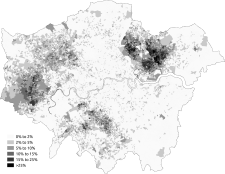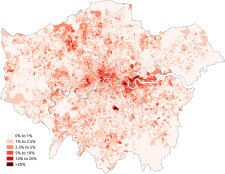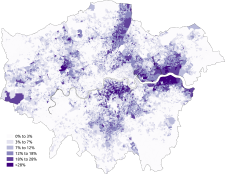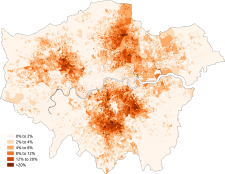Demographics of London


The demography of London is analysed by the Office for National Statistics and data is produced for each of the Greater London wards, the City of London and the 32 London boroughs, the Inner London and Outer London statistical sub-regions, each of the Parliamentary constituencies in London, and for all of Greater London as a whole. Additionally, data is produced for the Greater London Urban Area. Statistical information is produced about the size and geographical breakdown of the population, the number of people entering and leaving country and the number of people in each demographic subgroup.
Population change
See also Historical population of London
The historical population for the current area of Greater London, divided into the statistical areas of Inner and Outer London is as follows:[1][2][3]
| Year | 1801 | 1811 | 1821 | 1831 | 1841 | 1851 | 1861 | 1871 | 1881 | 1891 |
|---|---|---|---|---|---|---|---|---|---|---|
| Inner London | 879,491 | |||||||||
| Outer London | 131,666 | |||||||||
| Greater London | 1,011,157 |
| Year | 1901 | 1911 | 1921 | 1931 | 1941 | 1951 | 1961 | 1971 | 1981 | 1991 |
|---|---|---|---|---|---|---|---|---|---|---|
| Inner London | ||||||||||
| Outer London | ||||||||||
| Greater London |
| Year | 2001 | 2011[4] |
|---|---|---|
| Inner London | ||
| Outer London | ||
| Greater London |
| Year | Pop. | ±% p.a. |
|---|---|---|
| 1801 | 1,011,157 | — |
| 1811 | 1,197,673 | +1.71% |
| 1821 | 1,450,122 | +1.93% |
| 1831 | 1,729,949 | +1.78% |
| 1841 | 1,917,013 | +1.03% |
| 1851 | 2,286,609 | +1.78% |
| 1861 | 3,094,391 | +3.07% |
| 1871 | 3,902,178 | +2.35% |
| 1881 | 4,709,960 | +1.90% |
| 1891 | 5,565,856 | +1.68% |
| 1901 | 6,226,494 | +1.13% |
| 1911 | 7,157,875 | +1.40% |
| 1921 | 7,553,526 | +0.54% |
| 1931 | 8,098,942 | +0.70% |
| 1941 | 7,987,936 | −0.14% |
| 1951 | 8,164,416 | +0.22% |
| 1961 | 7,781,342 | −0.48% |
| 1971 | 7,449,184 | −0.44% |
| 1981 | 6,608,513 | −1.19% |
| 1991 | 6,887,280 | +0.41% |
| 2001 | 7,172,036 | +0.41% |
| 2011 | 8,173,941 | +1.32% |
| 2016 | 8,787,892 | +1.46% |
Race by borough
This table shows the proportion of each main race by London borough, as found in the 2011 census.
| Local authority | White | Mixed | Asian | Black | Other |
|---|---|---|---|---|---|
| Barnet | 64.1 | 4.8 | 18.5 | 7.7 | 4.9 |
| Barking and Dagenham | 58.3 | 4.2 | 15.9 | 20 | 1.6 |
| Bexley | 81.9 | 2.3 | 6.6 | 8.5 | 0.8 |
| Brent | 36.3 | 5.1 | 34.1 | 18.8 | 5.8 |
| Bromley | 84.3 | 3.5 | 5.2 | 6 | 0.9 |
| Camden | 66.3 | 5.6 | 16.1 | 8.2 | 3.8 |
| City of London | 78.6 | 3.9 | 12.7 | 2.6 | 2.1 |
| Croydon | 55.1 | 6.6 | 16.4 | 20.2 | 1.8 |
| Ealing | 49 | 4.5 | 29.7 | 10.9 | 6 |
| Enfield | 61 | 5.5 | 11.2 | 17.2 | 5.1 |
| Greenwich | 62.5 | 4.8 | 11.7 | 19.1 | 1.9 |
| Hackney | 54.7 | 6.4 | 10.5 | 23.1 | 5.3 |
| Haringey | 60.5 | 6.5 | 9.5 | 18.8 | 4.7 |
| Harrow | 42.2 | 4 | 42.6 | 8.2 | 2.9 |
| Havering | 87.7 | 2.1 | 4.9 | 4.8 | 0.6 |
| Hammersmith and Fulham | 68.1 | 5.5 | 9.1 | 11.8 | 5.5 |
| Hillingdon | 60.6 | 3.8 | 25.3 | 7.3 | 3 |
| Hounslow | 51.4 | 4.1 | 34.4 | 6.6 | 3.6 |
| Islington | 68.2 | 6.5 | 9.2 | 12.8 | 3.4 |
| Kensington and Chelsea | 70.6 | 5.7 | 10 | 6.5 | 7.2 |
| Kingston upon Thames | 74.5 | 3.9 | 16.3 | 2.5 | 2.7 |
| Lambeth | 57.1 | 7.6 | 6.9 | 25.9 | 2.4 |
| Lewisham | 53.5 | 7.4 | 9.3 | 27.2 | 2.6 |
| Merton | 64.9 | 4.7 | 18.1 | 10.4 | 1.9 |
| Newham | 29 | 4.5 | 43.5 | 19.6 | 3.5 |
| Redbridge | 42.5 | 4.1 | 41.8 | 8.9 | 2.7 |
| Richmond upon Thames | 86 | 3.6 | 7.3 | 1.5 | 1.6 |
| Southwark | 54.3 | 6.2 | 9.4 | 26.9 | 3.3 |
| Sutton | 78.6 | 3.8 | 11.6 | 4.8 | 1.3 |
| Tower Hamlets | 45.2 | 4.1 | 41.1 | 7.3 | 2.3 |
| Waltham Forest | 52.2 | 5.3 | 21.1 | 17.3 | 4.1 |
| Wandsworth | 71.4 | 5 | 10.9 | 10.7 | 2.1 |
| Westminster | 61.7 | 5.2 | 14.5 | 7.5 | 11.1 |
Ethnicity
The following table shows the ethnic group of respondents in the 2011 census in Greater London.
| Ethnic Group | 1991[5] | 2001[6] | 2011[7] | |||
|---|---|---|---|---|---|---|
| Number | % | Number | % | Number | % | |
| White: British[Note 1] | 4,287,861 | 59.79% | 3,669,284 | 44.89% | ||
| White: Irish | 256,470 | 3.83% | 220,488 | 3.07% | 175,974 | 2.15% |
| White: Gypsy or Irish Traveller[Note 2] | 8,196 | 0.10% | ||||
| White: Other[Note 3] | 594,854 | 8.29% | 1,033,981 | 12.65% | ||
| White: Total | 5,333,580 | 79.80% | 5,103,203 | 71.15% | 4,887,435 | 59.79% |
| Asian or Asian British: Indian | 347,091 | 5.19% | 436,993 | 6.09% | 542,857 | 6.64% |
| Asian or Asian British: Pakistani | 87,816 | 1.31% | 142,749 | 1.99% | 223,797 | 2.74% |
| Asian or Asian British: Bangladeshi | 85,738 | 1.28% | 153,893 | 2.15% | 222,127 | 2.72% |
| Asian or Asian British: Chinese[Note 4] | 56,579 | 0.84% | 80,201 | 1.12% | 124,250 | 1.52% |
| Asian or Asian British: Other Asian | 112,807 | 1.68% | 133,058 | 1.86% | 398,515 | 4.88% |
| Asian or Asian British: Total | 690,031 | 10.33% | 946,894 | 13.20% | 1,511,546 | 18.49% |
| Black or Black British: African | 163,635 | 2.44% | 378,933 | 5.28% | 573,931 | 7.02% |
| Black or Black British: Caribbean | 290,968 | 4.35% | 343,567 | 4.79% | 344,597 | 4.22% |
| Black or Black British: Other Black | 80,613 | 1.20% | 60,349 | 0.84% | 170,112 | 2.08% |
| Black or Black British: Total | 535,216 | 8.01% | 782,849 | 10.92% | 1,088,640 | 13.32% |
| Mixed: White and Black Caribbean | 70,928 | 0.99% | 119,425 | 1.46% | ||
| Mixed: White and Black African | 34,182 | 0.48% | 65,479 | 0.80% | ||
| Mixed: White and Asian | 59,944 | 0.84% | 101,500 | 1.24% | ||
| Mixed: Other Mixed | 61,057 | 0.85% | 118,875 | 1.45% | ||
| Mixed: Total[Note 5] | 226,111 | 3.15% | 405,279 | 4.96% | ||
| Other: Arab[Note 6] | 106,020 | 1.30% | ||||
| Other: Any other ethnic group | 113,034 | 1.58% | 175,021 | 2.14% | ||
| Other: Total | 120,872 | 1.81% | 113,034 | 1.58% | 281,041 | 3.44% |
| Total | 6,679,699 | 100.00% | 7,172,091 | 100.00% | 8,173,941 | 100.00% |
In January 2005, a survey of London's ethnic and religious diversity claimed that there were more than 300 languages spoken and 50 non-indigenous communities with a population of more than 10,000 in London.[8]
Country of birth
| Country of birth | Population |
|---|---|
| 5,175,677 | |
| 262,247 | |
| 158,300 | |
| 129,807 | |
| 114,718 | |
| 112,457 | |
| 109,948 | |
| 87,467 | |
| 84,542 | |
| 66,654 | |
| 65,333 | |
| 64,212 | |
| 63,920 | |
| 62,896 | |
| 62,050 | |
| 59,596 | |
| 57,765 | |
| 55,476 | |
| 53,959 | |
| 44,848 | |
| 44,199 | |
| 43,428 | |
| 41,041 | |
| 39,817 | |
| 39,452 | |
| 37,680 | |
| 37,339 | |
| 35,880 | |
| 32,136 | |
| 31,357 |
The 2011 census recorded that 2,998,264 people or 36.7% of London's population are foreign-born (including 24.5% born in a non-European country) making London the city with the second largest immigrant population, behind New York City, in terms of absolute numbers. The table to the right shows the most common countries of birth of London residents. Note that some of the German-born population, in 18th position, are British citizens from birth born to parents serving in the British Armed Forces in Germany.[10]
Languages
According to the 2011 Census, 6,083,420 or 77.9% of London's population aged 3 and over spoke English as a main language, with a further 1,406,912 (19.8%) speaking it as a second language or well to very well.[11] 271,693 (3.5%) could not speak English well, while 47,917 (0.6%) could not speak English at all.[11] 2,456 (<0.1%) spoke other UK minority languages, with the most common being Welsh and 2,926 (<0.1%) used British Sign Language.[12] This shows also great challenges for TfL and other government services, for example most ticket vending machines use only English, French and up to 2 other western Europe hemisphere languages, while as shown below most demand is for Indian languages, Polish etc.
The most common main languages spoken in Greater London according to the 2011 census are shown below.[13]
| Rank | Language | Usual residents aged 3+ | Proportion |
|---|---|---|---|
| 1 | English | 6,083,420 | 77.90% |
| 2 | Polish | 147,816 | 1.90% |
| 3 | Bengali (with Sylheti and Chatgaya) | 114,267 | 1.50% |
| 4 | Gujarati | 101,676 | 1.30% |
| 5 | French | 84,191 | 1.10% |
| 6 | Urdu | 78,667 | 1.00% |
| 7 | Portuguese | 71,525 | 0.90% |
| 8 | Turkish | 71,242 | 0.90% |
| 9 | Spanish | 71,192 | 0.90% |
| 10 | Arabic | 70,602 | 0.90% |
| 11 | Tamil | 70,565 | 0.90% |
| 12 | Punjabi | 68,525 | 0.90% |
| 13 | Somali | 54,852 | 0.70% |
| 14 | Italian | 49,484 | 0.60% |
| 15 | Romanian | 39,653 | 0.50% |
| 16 | Persian | 39,645 | 0.50% |
| 17 | Lithuanian | 35,341 | 0.50% |
| 18 | German | 31,306 | 0.40% |
| 19 | Greek | 26,924 | 0.30% |
| 20 | Russian | 26,603 | 0.30% |
| Other | 441,968 | 5.66% |
Religion
The following table shows the religion of respondents in the 2001 and 2011 censuses in Greater London.
| Religion | 2001[14] | 2011[15] | ||
|---|---|---|---|---|
| Number | % | Number | % | |
| Christian | 4,176,175 | 58.23% | 3,957,984 | 48.42% |
| No religion | 1,130,616 | 15.76% | 1,694,372 | 20.73% |
| Muslim | 607,083 | 8.46% | 1,012,823 | 12.39% |
| Religion not stated | 621,366 | 8.66% | 692,739 | 8.47% |
| Hindu | 291,977 | 4.07% | 411,291 | 5.03% |
| Jewish | 149,789 | 2.09% | 148,602 | 1.82% |
| Sikh | 104,230 | 1.45% | 126,134 | 1.54% |
| Buddhist | 54,297 | 0.76% | 82,026 | 1.00% |
| Other religion | 36,558 | 0.51% | 47,970 | 0.59% |
| Total | 7,172,091 | 100.00% | 8,173,941 | 100.00% |
Eurostat NUTS
In the Eurostat Nomenclature of Territorial Units for Statistics (NUTS), London is a level-1 NUTS region, coded "UKI", which is subdivided as follows:
| NUTS 1 | Code | NUTS 2 | Code | NUTS 3 | Code |
|---|---|---|---|---|---|
| London | UKI | Inner London | UKI1 | West Inner London (City of London, Camden, Hammersmith and Fulham, Kensington and Chelsea, Wandsworth, Westminster) | UKI11 |
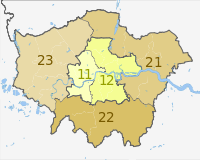
|
East Inner London (Hackney, Haringey, Islington, Lambeth, Lewisham, Newham, Southwark, Tower Hamlets) | UKI12 | |||
| Outer London | UKI2 | East and North East Outer London (Barking and Dagenham, Bexley, Enfield, Greenwich, Havering, Redbridge, Waltham Forest) | UKI21 | ||
| South Outer London (Bromley, Croydon, Kingston upon Thames, Merton, Sutton) | UKI22 | ||||
| West and North West Outer London (Barnet, Brent, Ealing, Harrow, Hillingdon, Hounslow, Richmond upon Thames) | UKI23 | ||||
Urban and metropolitan area
At the 2001 census, the population of the Greater London Urban Area was 8,278,251.[16] This area does not include some outliers within Greater London, but does extend into the adjacent South East England and East of England regions. In 2004 the London Plan of the Mayor of London defined a metropolitan region with a population of 18 million.[17] Eurostat has developed a harmonising standard for comparing metropolitan areas in the European Union and the population of the London Larger Urban Zone is 11,917,000; it occupies an area of 8,920 square kilometres (3,440 sq mi). Another definition gives the population of the metropolitan area as 13,709,000.[18]
See also
- Demography of the United Kingdom
- Demography of England
- Demography of Birmingham
- Demography of Greater Manchester
- Religion in London
- Religion in England
- List of English cities by population
- List of English districts by population
- List of English districts and their ethnic composition
- List of English districts by area
- List of English districts by population density
References
- ^ "London through time: Population Statistics: Total Population". A vision of Britain through time. Great Britain Historical GIS. Retrieved 19 November 2009.
- ^ "Outer London through time: Population Statistics: Total Population". A vision of Britain through time. Great Britain Historical GIS. Retrieved 19 November 2009.
- ^ "Inner London through time: Population Statistics: Total Population". A vision of Britain through time. Great Britain Historical GIS. Retrieved 19 November 2009.
- ^ "Archived copy" (PDF). Archived from the original (PDF) on 21 October 2014. Retrieved 6 June 2014.
{{cite web}}: Unknown parameter|deadurl=ignored (|url-status=suggested) (help)CS1 maint: archived copy as title (link) - ^ "1991 census – theme tables". NOMIS. Retrieved 20 January 2017.
- ^ "2001 census – theme tables". NOMIS. Retrieved 5 September 2014.
- ^ "Ethnic Group by measures". NOMIS. Retrieved 2 September 2014.
- ^ Benedictus, Leo (25 January 2005). "Every race, colour, nation and religion on earth". The Guardian. Retrieved 22 August 2009.
- ^ "Table QS213EW 2011 Census: Country of birth (expanded), regions in England and Wales". Office for National Statistics. 26 March 2013. Retrieved 15 July 2015.
- ^ Kyambi, Sarah (7 September 2005). Beyond Black and White: Mapping New Immigrant Communities. London: Institute for Public Policy Research. ISBN 1-86030-284-X.
- ^ a b "Proficiency in English, 2011 (QS205EW)". Office for National Statistics. Retrieved 17 April 2013.
- ^ "Main Language (detailed), 2011 (QS204EW)". Office for National Statistics. Retrieved 17 April 2013.
- ^ "Download:local authorities: county / unitary". NOMIS. Retrieved 5 September 2014.
- ^ "2001 census – theme tables". Retrieved 5 September 2014.
- ^ "Religion by measures". NOMIS. Retrieved 2 September 2014.
- ^ "KS01 Usual resident population: Census 2001, Key Statistics for urban areas". Office for National Statistics. Archived from the original on 11 March 2005.
{{cite web}}: Unknown parameter|deadurl=ignored (|url-status=suggested) (help) - ^ Mayor of London. "The London Plan". Greater London Authority.
- ^ "British urban pattern: population data" (pdf). ESPON project 1.4.3 Study on Urban Functions. European Spatial Planning Observation Network. March 2007. p. 119. Retrieved 22 February 2010.










